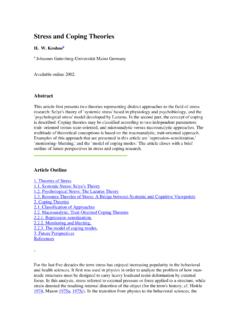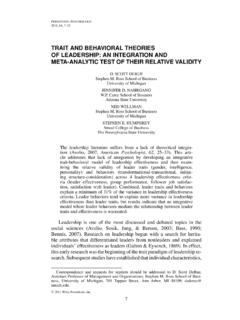Transcription of CULTURAL VARIATIONS IN LEARNING AND LEARNING …
1 269 Turkish Online Journal of Distance Education-TOJDE October 2012 ISSN 1302-6488 Volume: 13 Number: 4 Article 18 CULTURAL VARIATIONS IN LEARNING AND LEARNING STYLES Pegah OMIDVAR Bee Hoon TAN Department of English Language, Faculty of Modern Languages and Communication, Putra University, MALAYSIA ABSTRACT The need for cross- CULTURAL understanding of the relationship between culture and LEARNING style is becoming increasingly important because of the changing CULTURAL mix of classrooms and society at large. The research done regarding the two variables is mostly quantitative. This review summarizes results of the existing research on CULTURAL VARIATIONS in LEARNING styles. Limitations of the existing studies are discussed and some suggestion for future research is proposed.
2 Keywords: Culture, CULTURAL VARIATIONS , LEARNING , LEARNING styles INTRODUCTION Although culture has been defined differently, there is a universal definition of culture. Culture can be conceptualized as shared motives, values, beliefs, identities, and interpretations or meanings of significant events that result from common experiences of members of collectives that are transmitted across generations (House, Hanges, Javidan, Dorfman, & Gupta, 2004, p. 15). There are various areas where culture has been examined. Three areas which are more related to language and LEARNING include anthropology ( , Benedict, 1946; Kluckhohn, 1962; Hall, 1976), psychology ( , Markus & K itayama 1991; Triandis, 1995) and management ( , Hayashi, 1999; Hofstede, 1980).
3 Researchers ( , Bedell & Oxford, 1996) believe that language and culture are inseparable part of each other and comprehending a culture without paying attention to its language is impossible. On the other hand, it is also impossible to understand a language without its CULTURAL contexts. The two are strongly interwoven. It has been said that there is a clear and strong relationship between different categories of thought of a given community and the forms of language they use (Beattie, 1996). LEARNING involves human activities such as feeling, thinking, reflecting and doing (Kolb, 1984). Individuals have to learn to develop special abilities and preferences for such activities. These specialized abilities are called LEARNING stylex.
4 LEARNING styles are defined as individual consistencies in perception, memory, thinking and judgment across any stimulus condition (Curry, 2000, ). LEARNING styles have been investigated by many researchers and all agree on culture affects the development of LEARNING styles ( , Devita, 2001; Pratt, 1991; Katz, 1988; Barmeyer, 2004; Yamazaki & Attrapreyangkul, 2011; Gundaz & Ozcan, 2010; Yamazaki & Kayes, 2007). 270 DEFINING CULTURAL VARIATIONS Although numerous definitions have been offered by anthropologists and sociologists through the years, the concept of culture remains elusive, broad and ambiguous (Ball & Farr, 2003; Lessard-Clouston, 1997). Various elements constitute the cognitive and behavioral aspects of culture.
5 In other words, cultures are unified entities in which these elements exhibit strong inte rdependent relationships. Among the variety of elements, some elements such as language, gender, religion, and ethnicity do have a greater relevance to the notion of culture (Hall & Hall, 1990). People with similar cultures may speak different languages an d people belonging to different cultures may speak the same language (Beattie, 1996). It has been argued that culture and language, apart from their interrelationship, influence each other so much so that linguists use the term language to refer to the ab stract system underlying the collective totality of the speech and writing behavior of a community (Ball & Farr, 2003, p.)
6 436). Culture is defined by Hofstede, a prominent figure in the field of CULTURAL studies as the collective programming of the mind which distinguishes the members of one human group from another (Hofstede, 1980, p. 25), and is determined through institutions such as family, school, universities and work. Culture and LEARNING are connected in important ways. CULTURAL DIMENSIONS IN ANTHROPOLOGY Edward Hall and Ruth Benedict are among the main figures in this field. Hall (1976) classified culture to high-context and low-context cultures. In high-context cultures, non -verbal behaviors, external physical environment are important for its members in conveying the meaning in communication. For instance, Japanese, Chinese, French and Arabic countries represent high-context cultures.
7 In high-context cultures people value having long terms relationships (Yamazaki, 2005). Furthermore, looking at Kolb s LEARNING style model in relation to Hall s (1976) dimensions of culture by Yamazaki (2005) reveals that high-context cultures cherish interpersonal relationships and this trait goes well together with the concrete experience (CE ) abilities in which persons value relationships. In contrast, in low-context culture, explicit verbal messages are important in communication rather than non-verbal behaviors and external physical environment. Most information is conveyed through explicit codes, therefore explicit communicative style s in logical forms are highly valued. Interpersonal relationships last for a shorter time (Hall, 1976).
8 For instance, the United States, Switzerland and Germany present low-context cultures. It has been stated that communication patterns of low-context cultures are related to active conceptualization (AC) abilities, since those with low-context culture are likely to learn by logical thinking and analysis which accords to characteristics of AC abilities (Yamazaki, 1995). The second dimension of culture in the anthropology field which is classified by Benedict (1946) is shame versus guilt cultures. In the culture of shame, shame process relies on individual experience with their perception about surrounding audience and environment (Doi, 1979). It has been further explained that shame process is more related with CE abilities, since CE is an ability that can stir up shame emotion as a psychological reaction about one s behavior (Yamakazi, 2005).
9 271 In Guilt culture, the development of an individual conscious is important and the focus is on inner standards of behavior within the self rather than outer standards such as environment and audience (Benedict, 1946). Internalized criticism in guilt process activates reflective observation (RO) abilities. Consequently, the development of inner standards and internalized criticism leads us to conclude that guilt culture is conceptually related to RO abilities (Yamazaki, 2005). CULTURAL DIMENSIONS IN MANAGEMENT Another field of study from which culture has been examined is cross- CULTURAL management domain. In cross- CULTURAL management studies, the focus is on CULTURAL differences in values, perceptions, attitudes and behaviors in organizational settings.
10 Hofstede s model of CULTURAL dimensions and Hayashi s CULTURAL model of organization will be discussed in the review. Hofstede is one of the main figures in the field of management and organizational culture. Despite the existing criticism on his work, his model is influential in this field (Clark, 2003). Hofstede s four collectivism/individualism, power distance, uncertainty avoidance, masculinity/femininity dimensions are the most famous cross- CULTURAL work and still the major reference in today s cross- CULTURAL researches. Hofstede s CULTURAL framework has been applied in a wide variety of contexts by many researchers (Blodgett, Rose, Horton & Bakir, 2008). For example, they cited studies in management and marketing such as Alden, Hoyer and Lee (1993) that used Hofstede s framework to examine cross- CULTURAL differences in attitudes and behaviors.













